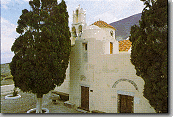|
|
 |

The Ladies in the wall-painting from the House of the Ladies are
depicted almost life-size with long black hair, golden earrings,
painted lips and cheeks and in Minoan garments,
beneath a starish sky (Athens, National Archaeological Museum).
|
Santorini is an island with a great history. It's all
waiting for you to be revealed in its museums, and archaeological sites.
Maritime museum
If you are looking to find out more about Santorini's maritime history, the Maritime Museum in Ia is
the place not to miss. Here you will find all kinds of displays featuring marine objects which trace the
history of the island, especially during the 19th century.
Opens daily from 11 am to 12 noon and
4
to 5 p.m.
Megaron Gyzi museum
The cultural center of the island is located in a
beautiful old mansion called the Megaron Gyzi.
Here, the visitor can spend some time observing
the exhibitions which give a cultural account of the
island's history as well as marvel at the unique 17th
century architecture of the mansion with its
dome-shaped rooms and pebble stone yards. The
1956 earthquake on the islands caused
considerable damage to the mansion but the
Catholic Diocese gathered enough funds to
restore it to its previous glory and turn it into a
cultural center. Among the exhibitions are old
manuscripts from the island of the 16th through the
19th century. If one has time, it's worth spending it
at the mansion-museum, especially to read some
of these manuscripts which give an excellent look
at life on Santorini hundreds of years ago. To get
an idea of the type of material you would be
reading, here are two examples from May 19,
1578: "...at the manor house of mistress
maroula Sigalena, Arlados Grimanis was
introduced and asked for the daughter of
mistress Katerina, to take her as his wife by betrothal. The mistress maroula accepts and
gives him a dowry of 1,700 doukata.Arlados Grimanis on his behalf
promises to give as dowry for him and his wife,
all that he owns and all that he will obtain. If
someone changes his mind, he'll have to pay a
fine of 100 jekinia, 50 to the proxy and 50 to
the party that kept the promise...".
"...the proxy of the catholics, and the proxy of the Orthodox
residents of Santorini came to an agreement
and exchanged two churches that were not in a
convenient place for either of them. The Catholics take Panaghia Rozaria's church and
the Orthodox the church of Megali Ekaterini in
Santorini..." Other exhibitions you can marvel at,
in the mansion-museum are engravings of the 16th through the 19th centuries with dresses, views and
maps of the Cyclades islands, some old
photographs of how Santorini looked before the
devastating earthquake of 1956 and paintings of
well-known Greek artists who worked on the
island. The center is open daily from 10:30 am to
1:30 pm and 5 to 8 p.m. there is a small admission
fee.For further information call (0286) 22244 or
22721.
The Church of Episkopi
Located in the village of Mesa Gonia is the
beautiful Byzantine church of Panagia Episkopi
well worth for a visit. The church is considered
the best example of traditional ecclesiastical
architecture of the island by Mathaios
Mendrinos, author of the booklet "The Church
of Episkopi in Santorini" which is distributed by
the Ecclesiastical Committee of the church. Mendrinos, who's is a member of the
G.P.P Academy of Rome, writes about the church.: "To every Greek, either coming as a
simple visitor or as a faithful to pray, this church,
inspires both a strong national and religious
feeling. National for his history, religious for its sarcacy. A great number of the treasures of the
church such as liturgical and ecclesiastical
books, priest's vestments and holy vessels were
destroyed by the 1915 fire. Only icons had
come out safe from the catastrophe. It is said
that a hand covered them by the fire and
protected them from being burned. It must have
been the invisible hand of the Virgin Mary."
 The church has survived the invasions of Venetians,
Francs, Russians and Turks and still remains as an
inspiration to the islanders. Panaghia Episkopi was
buit in 1115, but had to withstand not only
invasions and fires, but the tremendous earthquake
of 1956. Any damages incurred by all these
elements were quickly repaired by the faithful. The
church is not only known for its ecclesiastical
architecture. it is also admired for its remarkable
Byzantine paintings and hagiography. A number of
important icons can be seen in the church, although it bears to mention that 26 of the finest works were
stolen in 1982 and never to be found.
August 15th is the feast day of the church and after
religious ceremonies, the islanders join in
merrymaking with the visitors to Santorini with
plenty of food, dancing and singing. The church has survived the invasions of Venetians,
Francs, Russians and Turks and still remains as an
inspiration to the islanders. Panaghia Episkopi was
buit in 1115, but had to withstand not only
invasions and fires, but the tremendous earthquake
of 1956. Any damages incurred by all these
elements were quickly repaired by the faithful. The
church is not only known for its ecclesiastical
architecture. it is also admired for its remarkable
Byzantine paintings and hagiography. A number of
important icons can be seen in the church, although it bears to mention that 26 of the finest works were
stolen in 1982 and never to be found.
August 15th is the feast day of the church and after
religious ceremonies, the islanders join in
merrymaking with the visitors to Santorini with
plenty of food, dancing and singing.
Profitis Ilias Museum
High atop the Profitis Ilias peak, and in the monastery with the same name, is a museum containing
basically ecclesiastic items worth seeing for their craftsmanship and unique designs.
The museum contains all types of ecclesiastic items, some Byzantine documents, sacred vestments for
archbishops and bishops, relics of saints kept in silver boxes as well as monastic crafts.
Away from ecclesiastic subjects, the museum also hosts displays on shoemaking, printing, candle
making, wine making and of typical local food.
Ancient Thera
Ancient Thira is found on the mountain of Mesa
Vouno, resting in-between Kamari and Perissa.
This position was chosen by its founders,
Lacedaemonians colonizers in 1315, for its
strategic, protective and observatory qualities. It
was an ideal location for surveillance and control
of the South-East Aegean.
The bays of Kamari and Perissa provides excellent ports for the ships of these days. From
the 9th century B.C until the spread of Cristianity,
the city on Mesa Vouno was the only urban city of
the island. The first inhabitants were the Dorians,
the Cristians and the Venetians. All have
contributed to the architectural structure of the
city, but the most prominent being the Ptolemies,
during the hellenistic period. Excavations were first
carried by Hiller Von Gaertringen in 1895.But
these excavations were limited due to private
funds. Therefore, they concentrated mainly on
public buildings. This is why the entire picture of
Ancient Thira is still incomplete. All the streets
(level or stepped) were
paved with stones and frequently crossed by the
covered gutters which comprised the drainage
system of the city. The main material used for the
buildings, both public and private, was the local
grayish limestone. Sings to the sites are in German
due to the privately funded excavations.
FACTS
369 meters high, 800 meters in length,
150 meters wide
First excavated in 1895
INHABITED BY:
Dorian period (Spartans) 915 B.C - 315 B.C
Hellenistic Period (Ptolemies) 315 B.C - 197 B.C
Rhodians 197 B.C - 145 B.C
Roman Period 145 B.C - 300 A.D
Byzantine Period (Christians) 300 A.D-1204 A.D
Venetian Period 1204 A.D
Istorical and Cultural Museum
While many outstanding archaeological finds from Santorini will be found at the National
Archaeological Museum in Athens, the Historical and Cultural Museum of Santorini in Fira contains
artifacts from excavations on the island. Of note in the museum are a fine collection of geometric red
and black vases from the fifth century B.C.
Inscriptions are plentiful among the displays in the museum and a certain amount of Minoan ware is
also on exhibit. The museum also hosts impressive frescoes as well as sculptures of the Hellenistic
period, Byzantine works of art and even some remains of prehistoric times.
Open daily (except Mondays) from 8:30 am to 3 p.m. There is a small admission fee.
Akrotiri Excavations
At the southern end of Santorini is the ancient
excavation site of Akrotiri. This site is a must to
visit during your stay on the island and one which
will impress you. This is one of the archaeological
sites in Greece where a good guide, or at least a
good guide book, will come handy as
explanations are needed for one to really
appreciate what unfolds before you. Much of the
credit for the finds at Akrotiri, which date back
as early as 3000 B.C went to the late Dr
Spyridon Marinatos, a well known Greek
archaeologist. His work began in the early 30's
and lasted until the day he was killed during an
accident at the site in 1974. However work did
not stop there and continues even today, so don't
be surprised to see archaeologists busy at work
on the site. Professor Marinatos found the paved
streets of Akrotiri lined with multi story houses all
connected by a sophisticated central drainage
system. Most of the ground floor apartments
were used for storerooms, and hundreds of pithy jars and other utensils have been found within
them. The upper floors were the living quarters
for what appear to have been wealthy families;
each house had at least one room lined with
frescoes, some among the most magnificent yet
found in Greece. These, along with the best of the
pottery and stone vases unearthed at Akrotiri, are
on exhibit at the National Archaeological
Museum in Athens. The original inhabitants of the
town, used to the hazards of life on a volcano,
had enough warning from
earth tremors to clear out before the eruption,
dated about 1500 B.C.; the only remnant of a
living thing found during the excavation was the
skeleton of a pig. What happened to the people
once they left remains a mystery; they may have
made it to safety, although no traces have
been found, or they may have all died while escaping in
the tidal waves that followed the
eruption. The
archaeologists have added cement support to
walls already leaning before the earthquake, and
have replaced the wooden beams and frames that
were carbonized by the heat of the volcanic
eruption. Otherwise, no changes have been made
in the site, except to cover it with a protective roof.
The site is open daily from 8.30 to 3.00 except
Monday, with a small entrance fee charged.
regular bus service takes one to the Akrotiri
archaeological site from Fira and taxis are also
available in the main town.
|